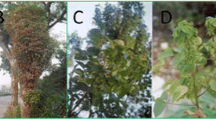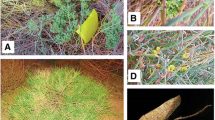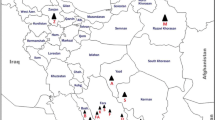Abstract
Phytoplasmas are agriculturally important pathogens for more than one thousand plant species. Jujube witches’ broom (JWB), a plant disease caused by phytoplasma, is highly fatal in Chinese jujube, an important fruit tree and medicinal crop in Asia. The 16S rDNA of 15 JWB isolates from 4 provinces in North China were amplified, cloned and sequenced. The isolates were over 99.8 % homologous, indicating that JWB phytoplasma is highly conserved. Phylogenetic analysis of the 16S rDNA sequences from those isolates, together with the representative phytoplasma sequences from other host species, showed that all JWB isolates belong to a subgroup of 16Sr V group and are closely related to Elm yellows (EY) phytoplasma. Virtual RFLP and single-nucleotide polymorphism (SNP) analysis of 16S rDNA also revealed that JWB isolates have a relatively low level of genetic diversity and that their SNP sites exhibit a strong bias toward A/G variation when compared with other phytoplasmas. The high similarity among JWB isolates from different regions and cultivars is consistent with the conserved symptoms of the disease and the wide infectivity of JWB phytoplasmas. This result provides valuable information to better understand the genetic diversity of JWB phytoplasmas.

Similar content being viewed by others
References
Assunta B, Bojan D (2009) Phytoplasma and phytoplasma diseases: a review of recent research. Phytopathol Mediterr 48:355–378
Chen N, Liu YG, Qiu PP, Liu WH, Su WM, Zhu XP (2015) Molecular identification and sequence polymorphism of phytoplasma associated with jujube witches’ broom in Shandong province. Acta Phytopathologica Sinica 45(2):113–120(in Chinese)
Gu PW, An FQ, Wu YF, Yang D, Luo CP, Xiang JY, Yang Y (2005) Comparison and analysis of 16S rDNA fragment of phytoplasma of wheat blue dwarf. Acta Phytopathologica Sinica 35(5):403–409(in Chinese)
Gundersen DE, Lee IM (1996) Ultrasensitive detection of phytoplasmas by nested-PCR assays using two universal primer pairs. Phytopathol Mediterr 35:144–151
Jung HY, Sawayanagi T, Kakizawa S, Nishigawa H, Wei W, Oshima K, Miyata S, Ugaki M, Hibi T, Namba S (2003) ‘Candidatus phytoplasma ziziphi’, a novel phytoplasma taxon associated with jujube witches’-broom disease. Int J Syst Evol Microbiol 53:1037–1041
Lee IM, Martini M, Marcone C, Zhu SF (2004) Classification of phytoplasma strains in the elm yellows group (16SrV) and proposal of ‘Candidatus phytoplasma ulmi’ for the phytoplasma associated with elm yellows. Int J Syst Evol Microbiol 54:337–347
Lee S, Han S, Cha B (2009) Mixed infection of 16S rDNA I and V groups of phytoplasma in a single jujube tree. The Plant Pathol J 25:21–25
Liu MJ, Zhao J, Zhou JY (2010) Jujube witches’ broom. China Agriculture Press, Beijing(in Chinese)
Santos-Cervantes ME, Chávez-Medina JA, Acosta-Pardini J, Flores-Zamora GL, Méndez-Lozano J (2010) Genetic diversity and geographical distribution of phytoplasmas associated with potato purple top disease in Mexico. Plant Dis 94:388–395
Strauss E (2009) Phytoplasma research begins to bloom. Science 325:388–390
Tamura K, Peterson D, Peterson N, Stecher G, Nei M, Kumar S (2011) MEGA5: molecular evolutionary genetics analysis using maximum likelihood, evolutionary distance, and maximum parsimony methods. Mol Biol Evol 28:2731–2739
The IRPCM Phytoplasma Working Team-Phytoplasma taxonomy group (2004) ‘Candidatus phytoplasma’ a taxon for the wall-less, non-helical prokaryotes that colonize plant phloem and insects. Int J Syst Evol Microbiol 54:1243–1255
Wei W, Davis RE, Lee IM, Zhao Y (2007) Computer-simulated RFLP analysis of 16S rRNA genes: identification of ten new phytoplasma groups. Int J Syst Evol Microbiol 57:1855–1867
Yang HX, Wang Y, Zhao YL, Zhao J, Liu MJ (2011) Molecular classification of jujube witches’ broom (JWB) associated phytoplasma from Ziziphus jujuba mill. ‘zanhuangdazao’. Scientia Agricultura Sinica. 44(21):4429–4437(in Chinese)
Zhao Y, Wei W, Lee IM, Shao J, Suo X, Davis RE (2009) Construction of an interactive online phytoplasma classification tool, iPhyClassifier, and its application in analysis of the peach X-disease phytoplasma group (16SrIII). Int J Syst Evol Microbiol 59:2582–2593
Author information
Authors and Affiliations
Corresponding authors
Additional information
Jiaodi Bu and Long Peng contributed equally to this work.
Electronic supplementary material
Fig. S1
Virtual 16S rDNA-RFLP fingerprints of JWB phytoplasmas in North China. Recognition sites for the following 17 restriction enzymes were used in the simulated digestions: AluI, BamHI, BfaI, BstUI (Thai), DraI, EcoRI, HaeIII, HhaI, HinfI, HpaI, HpaII, KpnI, MboI, MseI, RsaI, SspI, and TaqI. MW, QX174DNA-HaeIII digestion. 1–14, K and S were the same as in Fig. 1. (PDF 5.30 mb)
Rights and permissions
About this article
Cite this article
Bu, J., Peng, L., Liu, M. et al. 16S rDNA sequence analysis of witches’ broom phytoplasma isolates from Chinese jujube in North China. Australasian Plant Pathol. 45, 119–122 (2016). https://doi.org/10.1007/s13313-016-0396-5
Received:
Accepted:
Published:
Issue Date:
DOI: https://doi.org/10.1007/s13313-016-0396-5




